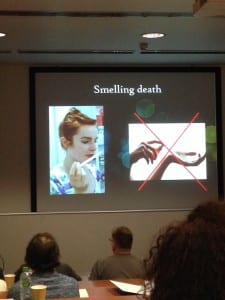Dead to me!
By Pia K Edqvist, on 12 July 2016
Human remains at the Petrie Museum. It’s time to come out of storage!
Death is part of life, and for me, death is very much a part of work since I am currently rehousing the human remains at the museum. In February, I attended a seminar at the Institute of Archaeology (IoA), PASSING ENCOUNTERS: The dead body and the public realm, the purpose of this was to stimulate discussion about death in an open and frank manner. I joined to learn more about how human remains are portrayed in social media and to gather people’s opinions on death. But, I learned much more than that; how a body decays, what different stages of decay smells like (See Fig.1.), and how death and the body have been portrayed throughout history
.
The human remains collection at the Petrie consists of around 80 human materials ranging from hair fragments to a nearly complete body. A multidisciplinary project was initiated by myself in 2015, with the aim of improving the current documentation, long-term accessibility, storage and research potential of these human remains. (See Fig.2.).

On left, skull of Inti, Army General securely mounted and housed. Right, box containing skull of Inti
The project’s objectives are:
-To preserve the human remains in this collection
-To create a dedicated storage space with suitable environmental conditions
-To develop a method of storage which is simple, quickly executed, inexpensive and easily adaptable
-To enable and ensure safe transportation
-To improve accessibility for teaching use and research
-To bring our storage policy in line with the 2005 guidance laid out by the Department for Culture, Media and Sport (DCMS)
-To collate all of the available documentation from its various sources, therefore increasing the value of this collection for teaching and research
The most exciting part of the project is the collaboration with Wendy Birch from Anatomy Lab, UCL, accessing the specimens with radiographs and CT scans in order to create accurate anatomical descriptions. An initial session of radiographs was made of six human remains at University College London Hospitals (UCLH), (See Fig.3.) the interpretation of the radiographs is still being researched.

Radiographs executed at UCLH. Image showing radiographer on the right looking at a screen showing a radiograph of a skull
Wendy and I presented a talk at the two day conference Corpses, Cadavers & Catalogues-The Motilities of Dead Bodies and Body Parts, Past and Present at the Barts Pathology Museum and the Huntarian Museum at the Royal College of Surgeons, London. The talk focused on sharing our research on the project. (See Fig.4.).

Pia Edqvist presenting at Barts Pathology Museum on the subject of the human remains in the Petrie Museum collections
The conference was fascinating, with a diversity of subjects presented such as the shortage of cadavers in Edwardian times, the indigenous perspective on the repatriation of human remains from a Maori context and the grave robbing of Sami remains in Norway. The conference gave me a new perspective but also was a great opportunity for sharing and exchanging knowledge and it allowed us to seek advice about a future catalogue of the human remains at the Petrie Museum.
There will be more blogs on this subject so keep watching this space for updates.
Pia Edqvist is the Curatorial Assistant at the Petrie Museum of Egyptian Archaeology
Further information:
Links to other blogs from UCL Museums and Collections, relating to human remains, display and ethics from the Grant Museum and from the Petrie Museum .
 Close
Close


